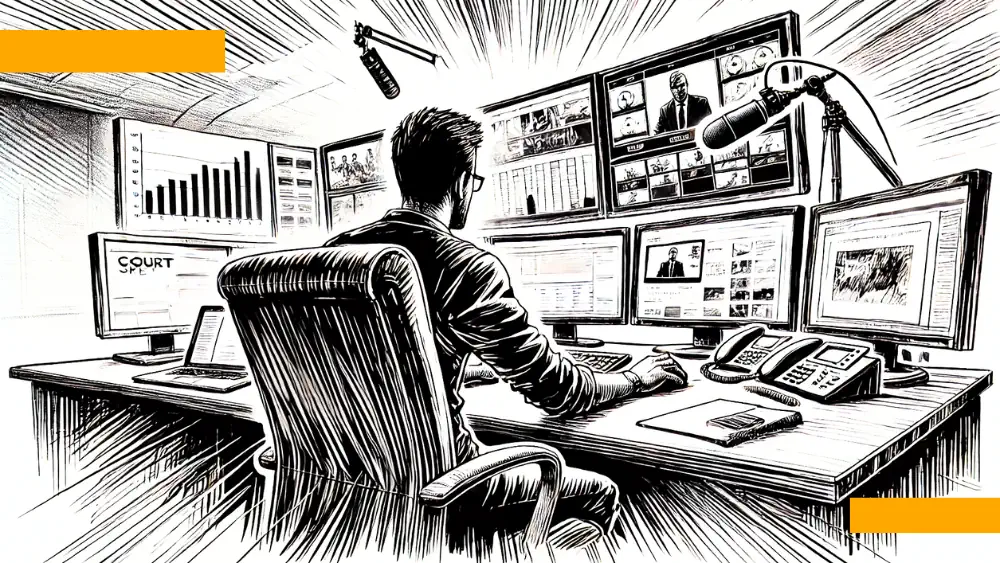 illustration: DALL-E
illustration: DALL-EComputer-Assisted Reporting, or CAR, is simply the use of technology for gathering, analyzing, and presenting information. It is not about replacing reporters with machines but rather about supporting their work through algorithms, databases, and advanced analytical tools.
CAR gained popularity as early as the 1990s when journalists started using databases to uncover scandals. Today, the tools are more advanced, and the range of possibilities is virtually unlimited.
How Technology Supports Journalists
Modern journalism is increasingly data-driven. Computer assistance is useful in many areas of daily work. CAR allows journalists to access and collect information more quickly, analyze and compare it more precisely, and present the results in an engaging way. The result is more accurate, comprehensive, and compelling content.
Analyzing Large Data Sets
Manually searching through hundreds of thousands of documents, reports, or data leaks is impossible. That’s why journalists use data exploration tools. An example? The Panama Papers scandal, where journalists analyzed 11.5 million documents, exposing a network of offshore companies used to hide wealth.
Fact-Checking and Detecting Fake News
In the age of disinformation, CAR helps verify facts. Tools like Google Fact Check Explorer, Snopes, and natural language processing algorithms allow for faster identification of false information.
Data Visualization
Good journalism is not just about numbers but also how they are presented. Infographics, interactive maps, and charts help readers understand even complex topics. Popular tools include Canva, Tableau, Flourish, and Datawrapper. A great example is The Guardian Data Blog, which uses data to create accessible reports and analyses, demonstrating how digital journalism can simplify complex issues.
Automating Reports
Some content - such as sports results or stock market reports - can be generated automatically. Many newsrooms, including Reuters and The Washington Post, use AI tools to write short notes and analyses.
However, it is fair to admit that computer-assisted journalism is not without flaws, concerns, and challenges. Using web scraping and social media monitoring raises questions about privacy and journalistic ethics. Some advanced CAR tools are expensive, posing a barrier for smaller newsrooms. Journalists also need the right technical skills to use CAR tools effectively. Lastly, an overreliance on technology could erode traditional journalism, including in-person interviews, field reporting, and even writing stories independently. Caution is needed.
Practical Applications of CAR
The potential is enticing, and the results can be spectacular. Computer-Assisted Reporting is used in various areas of journalism, from corruption investigations to analyzing social trends. CAR is not just a theory - journalists worldwide apply these methods in practice. Here are some concrete examples:
Investigative Journalism
Investigative journalists use CAR to sift through financial documents, company records, and databases to uncover irregularities and corruption. These methods helped expose the Panama Papers scandal - an enormous case of hidden wealth by politicians and celebrities in tax havens.Political Journalism
Analyzing open sources, voting records, and archived speeches helps track politicians’ activities. CAR tools assist in comparing election promises with actual actions, examining financial ties, and investigating who influences government decisions.Disaster and Pandemic Reporting
During the COVID-19 pandemic, journalists used big data analysis to report infection rates, hospital capacity, and vaccine effectiveness. Similarly, in natural disasters, satellite and meteorological data analysis helps predict the impacts of earthquakes, hurricanes, and floods.Studying Social Trends
Social media data, market reports, and economic statistics help predict social and economic shifts. This allows analysis of topics such as the impact of inflation on consumer behavior or migration trends.
One important note: CAR tools support journalists, but they are still just tools. Numbers (usually) don’t lie, but interpreting them is an art. And who better than journalists to extract a story from numbers that no one wanted to tell?
Is CAR Changing the Role of Journalists?
Yes, but it does not mean that reporters will become obsolete. On the contrary, their role now involves not only gathering facts but also interpreting data, asking the right questions, and recognizing hidden connections. Traditional investigative journalism is now combined with data analytics. Those who master these skills will become invaluable specialists in the future. Because while computers are fast, they still lack one crucial thing - human intuition.
So no, journalists will NOT be replaced by algorithms - machines can process data, but humans give it context and uncover real stories. It is still people who (for now) ask the key question: "What does all this mean?".
COMMERCIAL BREAK
New articles in section Skills and knowledge
War reporter in the new reality. Evolving techniques, same purpose
KFi
What happens when war breaks out just across the border and journalists aren't ready? Polish reporters faced that question after Russia invaded Ukraine in 2022. Lacking training, they improvised: blurred details, hid names, and balanced trauma with truth.
A heuristic trap in media coverage. How loud headlines boost fear
Bartłomiej Dwornik
A negative message that rests on emotion lifts the sense of threat by 57%. Why do reports of a plane crash drive investors away from airline shares? Why do flood stories spark worry about the next deluge? The pattern is irrational yet clear and proven.
How LLMs are reshaping SEO. Smart content strategies for the age of AI
BDw
For years, SEO was a fairly predictable game. Pick the right keywords, optimize your content, and watch your website climb the rankings. But today, a silent revolution is underway - and it`s being led by large language models (LLMs) like ChatGPT, Claude, Gemini, and DeepSeek.
See articles on a similar topic:
Readability: Tools for Journalists to Enhance Text Clarity
Bartłomiej Dwornik
Even the most substantive content must be presented in an accessible and visually appealing way. First, so the reader can understand it. Second, to be easy on the eyes. In both cases, machines can help. Here are some tools for measuring text readability that every journalist might find useful.
It's Easier to Lie and Swear in Foreign Language. Here is Scientific Proof
Ewelina Krajczyńska-Wujec
A decision made based on data presented in a learned foreign language may be different than if you made it based on data in your native language. Language changes the intensity of felt emotions, and it affects the ability to analyse problems and choose solutions, according to research by Rafał Muda, PhD.
Traditional Media Still Plays a Key Role in PR
Flor Calveiro
The latest trend research from Worldcom PR Group EMEA has shown that, despite the growing importance of social media, the position of "traditional" media remains steadfast and continues to play a key role in public relations activities.
Max Weber's Theory of Political Sociology
Krzysztof Dowgird
Max Weber, a German sociologist who lived from 1864 to 1920, was undoubtedly the greatest non-Marxist sociologist of political relations. He had a tremendous and enduring impact on many branches of social sciences, including the sociology of political relations.





























